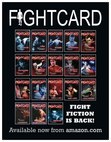Jack Tunney's Blog, page 28
February 26, 2014
FIGHT CARD AND THE WORLD OF LUCHA LIBRE
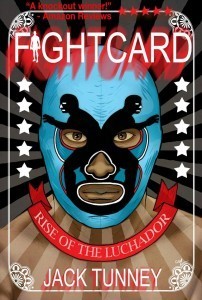 FIGHT CARD AND THE WORLD OF LUCHA LIBRE
FIGHT CARD AND THE WORLD OF LUCHA LIBREJASON RIDLER
When most people think pro wrestling, they think America. Hulk Hogan. Stone Cold Steve Austin. The Rock.
But there is great wrestling from around the world…Japan, Canada, Germany, and many other countries…Each with its own unique style and fans. Among these unique forms, none is more dramatic and insane then that of the world of Lucha Libre in Mexico. Growing up in the Great White North, I didn’t catch too much of this world. Like most of my American peers, my TV was dominated with American and Canadian wrestlers. However, down Mexico way there was a secret world of masked wrestlers — and they were heroes!
North of the border, masked men were almost always villains – hiding their identity. Many were out of shape, has-been grapplers who needed a paycheck – yeah, I’m looking at you, Spoiler II. However, in the world of Mexican Lucha Libre wrestling, masked men were (and continue to be) the stars who crush the no-mask rudo villains into the mat. They use high flying moves and ring gymnastics, which defied physics, and many believe (truly believe) these heroes have been granted magic powers.
Luchadors like Santo and Blue Demon were modern folk legends, with piles of great B-movies where they fight gangsters, monsters, and communists. I originally read about them in smelly newsprint magazines with glossy covers, wishing I could see these titans from Mexico on the screen.
Rise of the Luchador is my attempt to make an old wish come true, the wish of a kid who only got to see the descendants of great luchadors in America. I’m best known for writing novels with wrestlers in them (Death Match) or street fighters (Blood and Sawdust), but I really wanted to write about the tension between these two worlds of shoots (real fights) and works (scripted bouts).
Real combat arts are about predation, survival, and dominance. They are practiced by those who want to see who is best at crippling the other guy. Wrestling is the reverse. It went from being a combat art, to a con-game, and then to an art form – telling stories with pretend violence that relies on massive amounts of cooperation.
I could think of no bigger pressure cooker to put our street-fighting hero Carlos in than a wrestling ring. The result is pure dynamite. Hope you enjoy my addition to the Fight Card saga – Rise of the Luchador!
February 8, 2014
THE COLLECTED BOXING STORIES OF ROBERT E. HOWARD BOOK 2: FISTS OF IRON
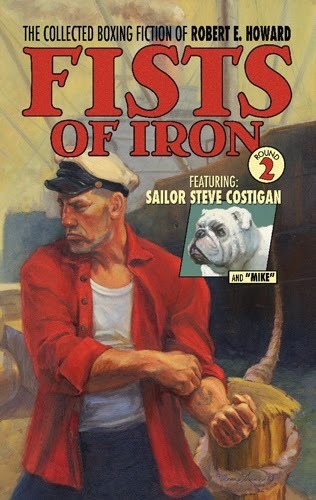
THE COLLECTED BOXING STORIES
OF ROBERT E. HOWARD
BOOK 2: FISTS OF IRON
NOW AVAILABLE
The REH Foundation Press is proud to present Fists of Iron, Round 2, the second volume of a four-volume series featuring the Collected Boxing Fiction of Robert E. Howard. This volume features the first half of the collected Sailor Steve Costigan yarns and measures in at 330 pages (plus introductory material). It is printed in hardback with dust jacket, with the first printing limited to 200 copies, each individually numbered. Cover art by Tom Gianni and introduction by Mark Finn. Other volumes will follow as their covers are completed.
CONTENTS
Tall Lying in the Far East: Robert E. Howard, Sailor Steve Costigan, and the Narrative Idyll, by Mark Finn
FIST OF IRON
The Pit of the Serpent
By the Law of the Shark
The Bull Dog Breed
Sailors’ Grudge
Fist and Fang
Winner Take All
Waterfront Fists
The Champion of the Forecastle
Alleys of Peril
Waterfront Law
Hard-Fisted Sentiment
The Yellow Cobra
A Student of Sockology
Texas Fists
The Fightin’est Pair
Cultured Cauliflowers
APPENDIX
Blue River Blues
Sailors’ Grudge (outline)
The Battling Sailor (incomplete, originally untitled)
Untitled (It was the end…)
Untitled (The night Sailor Steve Costigan…)
Alleys of Peril (synopsis)
Untitled Mike O’Brien fragment (“Help! Help! They’re murderin’ me!”)
The Lord of the Ring (part 2), by Patrice Louinet
FOR MORE INFO CLICK HERE
February 6, 2014
FIGHT CARD UPDATE
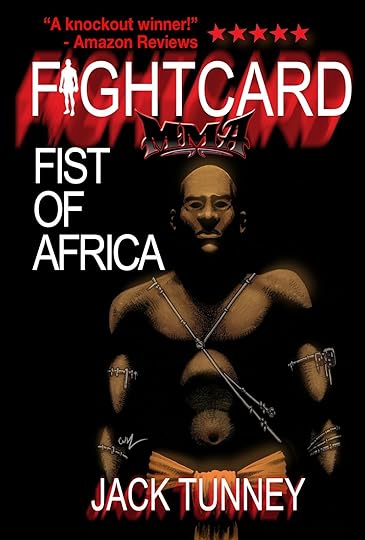
FIGHT CARD UPDATE
Our latest entry Fight Card MMA: Fist Of Africa from Balogung Ojetade with a cover by Carl Yonder has just been released:
FIGHT CARD MMA: FIST OF AFRICA
Nigeria 2004 … Nicholas ‘New Breed’ Steed, a tough teen from the mean streets of Chicago, is sent to his mother’s homeland – a tiny village in Nigeria – to avoid trouble with the law. Unknown to Nick, the tiny village is actually a compound where some of the best fighters in the world are trained. Nick is teased, bullied and subjected to torturous training in a culture so very different from the world where he grew up.
Atlanta 2014 … After a decade of training in Nigeria, a tragedy brings Nick back to America. Believing the disaffected youth in his home town sorely need the same self-discipline and strength of character training in the African martial arts gave him, Nick opens an Academy. While the kids are disinterested in the fighting style of the cultural heritage Nick offers, they are enamored with mixed martial arts. Nick decides to enter the world of mixed martial arts to make the world aware of the effectiveness and efficiency of the martial arts of Africa.
Pursing a professional career in MMA, Nick moves to Atlanta, Georgia, where he runs into his old nemesis – Rico Stokes, the organized crime boss who once employed Nick’s father, wants Nick to replace his father in the Stokes’ protection racket. Will New Breed Steed claim the Light Heavyweight title … Or will the streets of Atlanta claim him?
Any mentions on your social networking or blog sites are appreciated.
Next up is Fight Card: Rise Of The Luchadore from Jason Ridler with another stunning cover by Carl Yonder.
I’m currently editing books from Brian Drake (tentative title: Copper Town Champ). Joseph Grant (Guns of November), Jason Chirevas (Monster Man), and Mark Finn (The Adventures Of Sailor Tom Sharkey) along with short stories for our second charity anthology.
Look for some big news on the Fight Card marketing front in our next update …
Keep Punching …
February 5, 2014
BALOGUN OJETADE ON WRITING FIGHT FICTION

WRITING FIGHT FICTION
BALOGUN OJETADE
I am a writer.
I write speculative fiction – mainly Steamfunk, Urban Fantasy and Sword & Soul.
Recently, I have expanded my writing into the Pulp genre of Fight Fiction, which was pretty much inevitable because my novels contain lots of exciting action and fight scenes.
What is Fight Fiction. You ask?
Fight Fiction is comprised of tales in which the fighting – whether it happens in a temple in Thailand, a boxing ring in Las Vegas, a cage in Atlanta, or in a bar in New York City – is not merely in the story to make it more exciting; or to add a different spin to it. The fighting must be an integral part of both the story and its resolution. Take the fighting out and you no longer have a story. Think Fight Club; Rocky; Blood and Bone; Kung-Fu Hustle; Million Dollar Baby; and Tai Chi Zero.
My friend, renowned spoken word artist XPJ Seven, once told me “Dude, I like your fight scenes.”
“What do you like about them?” I inquired.
“They’re not like the fight scenes in most of the fiction I’ve read.” He replied, his brow wrinkling as he scowled.
“What’s wrong with those fight scenes?” I asked.
The wrinkles in XP’s brow deepened into canyons as he frowned in disgust. “Dude…they’re wack!”
Can’t argue with the wisdom of XP.
Thus, I write this as a helping hand to my fellow writers who may struggle with writing fight scenes. If writing fight scenes for you comes easy, please, keep reading; you’re already here…you might as well. And – in the spirit of all things not wack – if you will be so kind as to contribute your wisdom to this post, it will be greatly appreciated.
Writing fight scenes has always been something I enjoy and that I believe I do fairly well. This is probably due to the fact that I have been a student of indigenous African martial arts for over forty years and I have been n instructor of those same martial arts for nearly thirty years. I am also a lifelong fan of martial arts, boxing and action films.
Thus, I share with you what little I know about writing fight scenes in the following Fight Scene Plan, which I hope will help guide you toward the light at the end of that dark, dank tunnel called wackness.
Just remember – all good plans are malleable. As my good friend, author Milton Davis, says, “A plan is a work in progress. It must be adjusted and modified based on results. An inflexible plan will eventually lead to failure.”
FIGHT SCENE PLAN
SHOW, DON’T TELL
I put this point first because it seems to be the one most writers have difficulty with when writing a fight scene.
Here is an example of telling:
After taking eight punches and several kicks to now vital areas all over her sinewy frame – such as her solar plexus, spine and head – Harriet Tubman staggered backward, wailing in agony.
This is “telling” because the punches and kicks are all lumped together, making it impossible to say, with any certainty, how many blows Harriet actually suffered.
Furthermore, we cannot be sure of exactly which body parts are suffering all the punishment, although we get a grocery list of a few parts that might be getting damaged…or might not – who knows?
Finally, what is Harriet doing while she is taking that beat-down? Just accepting it all willy-nilly? Does she throw a counterpunch? Beg for mercy? Scream “Feets don’t fail me now” and then haul ass? We don’t know. We cannot see this scene. We cannot see Harriet. We’re just being told about it. Wack.
SHOW SEQUENCE, NOT SIMULTANEITY
It rarely makes sense to make two different actions simultaneous in a fight scene.
Why?
Because a fight scene is loaded with different sorts of actions, each of which takes a different amount of time.
If one action takes a tenth of a second and another takes two seconds, the action will feel distorted if the author asserts that they happen simultaneously.
For example:
John Wilkes Booth ducked his head and whirled to the right, simultaneously kicking furiously with his right heel as he shouted “Harriet Tubman, you just will not die, will you?”
Now, you can whirl to the right pretty quickly. You can kick pretty quickly. But how long does it take to shout ‘Harriet Tubman, you just will not die, will you’? All this action cannot happen simultaneously. So, writing something like this? Wack.
ENFORCE CAUSALITY
A Cause should be shown first, and then the Effect shown afterward. Showing the Effect and then the Cause? Wack.
Case in point:
John Wilkes Booth ducked his head and whirled to the right. He kicked furiously with his right heel as he shouted “Harriet Tubman, you just will not die, will you?” Just after he spotted Harriet throwing another punch at him.
So, what happened first? Booth saw Harriet throw another punch at him. However, that is shown last in the passage. The Effect is shown first, followed by a long sequence of events: Booth ducks his head; Booth spins to the right; Booth kicks; Booth shouts; only after all that are we shown the Cause of it all.
SHOW THE FASTEST ACTION FIRST
When you sequence a group of actions that happen at roughly the same time, show those actions that happen fastest before you show those that happen slowest.
Do not write the passage this way:
The steambot was no longer a threat to Harriet, as it lay broken in the dirt, wondering if it would ever see its beloved creator – Mistress Nakamura – again, the very woman who had nurtured it and taught it love, an agonizing scream escaped its metallic throat.
We see the steambot pondering whether it would see its creator again and then we see it scream in agony. A scream usually takes less time than a deep pondering, so it is better to show the steambot scream first and then show it ruminate.
Showing the slower action before the faster one? Wack.
FOR EVERY ACTION, SHOW A REACTION
A fight scene should be written in this order: Action then Reaction. The Steambot slams an elbow into Harriet Tubman’s jaw; she staggers backward. Harriet whips a roundhouse kick at the Steambot’s head; it blocks and swings a back-fist at her temple.
See? Action…Reaction. Writing the character’s Reaction before the Action is backpedaling toward wackness. Case in point:
Harriet staggered backward when the steambot slammed its elbow into her jaw.
The Reaction – staggering backward – took place before the Action – the elbow to the jaw. Wack.
Each Action – Reaction should have its own paragraph. This, however, is not always possible. Sometimes, the sentences are too short to have their own paragraphs and can be combined. It’s up to you how to format it.
The steambot exploded forward with a powerful uppercut.
Harriet leaned backward to evade the blow. A breeze slithered up her face as the steambot’s iron knuckles swished past her nose.
Or
The steambot exploded forward with a powerful uppercut. Harriet leaned backward to evade the blow. A breeze slithered up her face as the steambot’s iron knuckles swished past her nose.
MAKE IT HAPPEN IN REAL TIME
When writing your Action – Reaction, be sure to make it happen in Real Time. When a fight is happening, you see one punch and then right away, you see the response; and then right away, you see the next punch. During a fight in Real Time, you do not have time for such contemplations as this:
The steambot’s elbow slammed into Harriet’s jaw. She staggered backward. She was hurt quite badly; perhaps not as badly as when she shattered her shin against the thigh of that giant knoll, but badly, just the same.
This should be written this way:
The steambot’s elbow slammed into Harriet’s jaw. She staggered backward.
CONTROL THE PACE
Pace is important in a fight scene.
It is not cinematic – and you want your fight scene to play like a movie in the reader’s head – to show a nonstop flurry of Actions and Reactions.
Even a warrior who possesses extraordinary gifts like Harriet Tubman has to catch her breath.
A cinematic fight has ebbs and flows in the pacing.
You show the faster parts of the scene with short sentences that show only the Actions and Reactions.
Use short sentences and phrases to make reading flow run faster. Long, descriptive sentences slow the reading pace.
In a fight scene, you want your reader to roll with each punch; shift in his or her seat with each kick.
Fast reading pace is essential. Use only a phrase, sentence, or – at most – two short sentences for each action. You can also combine short phrases together, since each phrase will still let the action move along:
Harriet paused, listening for movement. The whisper of a footstep to her right. She whirled, exploded forward, felt her knee connect with muscled flesh and then heard a soft thud as Booth fell to the floor.
Conversely, reading flow can also become bogged down if there are too many sentences of the same length one after the other. Cases in point:
He kicked. She ducked. He chopped. She whirled.
Or
Harriet turned at the sound of running feet. Booth crashed into her as she stood there. Her body struck the table with a thundering crash. Splinters stabbed into the back of her neck.
Continue to avoid long, rambling description, but vary your sentence and phrase length:
Running feet. Harriet turned. Booth crashed into her, slamming her into the table with a thundering crash. A low gasp escaped Harriet’s lips as splinters stabbed into the back of her neck.
You can also show the slower parts of the scene with longer sentences that show Actions and Reactions interspersed with dialogue and interior monologue.
To do otherwise? Wack.
FAVOR COMPLETED VERBS OVER CONTINUING ACTION VERBS
Use simple past tense verbs, such as kicked, ran or leapt rather than participles such as kicking, running or leaping.
When you say Harriet head-butted Booth, you imply that it happened quickly and the act is now over. When you say Harriet was head-butting Booth, you imply that the act is going on and on and on. A head-butt happens in a fraction of a second, so writing “head-butting” causes the reader to envision the head-butt happening over and over and over again. Or they envision it happening in slow motion. Either way, it is not much like a fight anymore, is it? Wack.
Finally, remember that a good fight scene is about momentum and rhythm.
Jackie Chan once gave me some advice on choreographing a fight scene (yep, the Jackie Chan – I’ll tell you that story one day) that I now use in my writing. “The rhythm of a fight scene sells it. I use African and Japanese drum rhythms for my fights. Those rhythms draw the audience in and make them love the fight.”
Each move should flow from where the last one ended. If your hero throws a spinning back kick, where is her weight when she lands? Is she standing straight or bent at the waist? In what direction is her body leaning? The next blow she delivers should follow the same line of momentum. If she kicked in a clockwise motion, her next kick will also probably be clockwise.
Try to act out fight sequences – or, if you live off a steady diet of Krispy Kreme donuts and Coca Cola, ask someone else to do it – in order to figure out momentum and balance, which creates rhythm. Throw a punch and observe how your weight shifts, or what area of your body is exposed.
I often act out the entire fight scene with my wife. We are both career martial artists, so, for us, it comes easily. However, if you do not happen to have a spouse that is a martial arts expert handy, watch movies for ideas (or call me – I choreograph fight scenes for films, theater, comic books and novels…for a meager fee).
Finally, choose the type of fights you want in your story. Do you want gritty, brutal fight scenes such as the ones in Steven Seagal’s Above the Law or in The Bourne Identity (the 2002 movie, not the 1988 television miniseries)? Or do you want Hong Kong Cinema-styled fights, such as the ones in The Matrix, Inception, or Crouching Tiger, Hidden Dragon? Most readers will follow either style as long as they make sense and are a good match with the genre you are writing in.
Recently, I joined a team of stellar authors, who all write under the pen name Jack Tunney, as part of the Fight Card series imprints.
When I spoke to Paul Bishop, who – along with author Mel Odom created the Fight Card concept – he expressed an interest in my protagonist, Nick ‘New Breed’ Steed and the story of his coming of age as a fighter in the Adewale Wrestling Compound in Oṣogbo, Oṣun State, Nigeria. I was happy because I have always wanted to share with the world the fierceness, efficiency and effectiveness of the indigenous African martial arts for self-defense, as well as their transformative powers in the building of men and women with self-discipline, courage and good character. Fight Card MMA was a perfect outlet for my unique brand of Fight Fiction, which I am sure you will enjoy reading as much as I enjoyed writing it.
In Fist Of Africa, readers will experience jaw-dropping action on the mean streets of Chicago, in the sand pits of Nigeria and in cages in the “Dirty South” (Atlanta).
AVAILABLE NOW ~ FIGHT CARD MMA: FIST OF AFRICA

AVAILABLE NOW ~ FIGHT CARD MMA: FIST OF AFRICA
BALOGUN OJETADE WRITING AS JACK TUNNEY
Nigeria 2004 … Nicholas ‘New Breed’ Steed, a tough teen from the mean streets of Chicago, is sent to his mother’s homeland – a tiny village in Nigeria – to avoid trouble with the law. Unknown to Nick, the tiny village is actually a compound where some of the best fighters in the world are trained. Nick is teased, bullied and subjected to torturous training in a culture so very different from the world where he grew up.
Atlanta 2014 … After a decade of training in Nigeria, a tragedy brings Nick back to America. Believing the disaffected youth in his home town sorely need the same self-discipline and strength of character training in the African martial arts gave him, Nick opens an Academy. While the kids are disinterested in the fighting style of the cultural heritage Nick offers, they are enamored with mixed martial arts. Nick decides to enter the world of mixed martial arts to make the world aware of the effectiveness and efficiency of the martial arts of Africa.
Pursing a professional career in MMA, Nick moves to Atlanta, Georgia, where he runs into his old nemesis – Rico Stokes, the organized crime boss who once employed Nick’s father, wants Nick to replace his father in the Stokes’ protection racket. Will New Breed Steed claim the Light Heavyweight title … Or will the streets of Atlanta claim him?
January 23, 2014
FIGHT CARD & THE FIGHTER
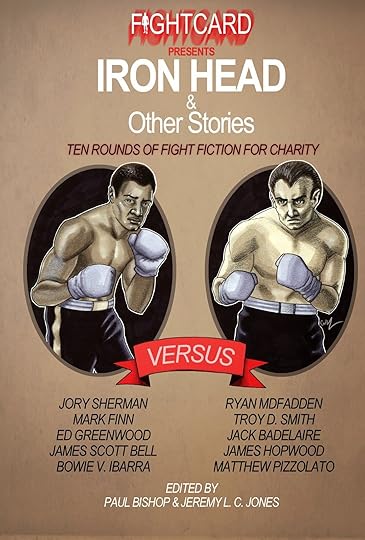
FIGHT CARD & THE FIGHTER
JEREMY L.C. JONES, CO-EDITOR OF THE JUST RELEASED CHARITY ANTHOLOGY FIGHT CARD PRESENTS: IRON HEAD AND OTHER STORIES, GIVES US HIS TAKE ON THE PROJECT …
Fight Card Presents: Iron Head & Other Stories is the first in a series of charity anthologies from the Fight Card authors cooperative – a writers community featuring many of today’s finest fictioneers, including Jory Sherman, Ryan McFadden, Mark Finn, Troy D. Smith, Ed Greenwood, Jack Badelaire, James Scott Bell, James Hopwood, Bowie V. Ibarra, and Matthew Pizzolato.
Compiled by Paul Bishop and Jeremy L. C. Jones, 100% of the proceeds from these anthologies will go directly to an author-in-need (in this case, revered western writer Jory Sherman) or a literacy charity. Words on paper are the life blood of a writer. The writers in this volume were willing to bleed in order to give a transfusion to one of their own – and then continue to bleed to give a transfusion to literacy charities in support of that most precious of commodities … readers. They are true fighters, every one …
FIGHT CARD & THE FIGHTER
Jory Sherman is a fighter. He’s been in the writing business all of his adult life. He’s been a poet, a journalist, and a novelist. He’s penned short stories, radio scripts, and autobiographical essays. In his memoir, he never flinches or falters. He’s written horror, action-adventure, and westerns, both adult and traditional. His publication numbers are high. Short stories? Over 50. Novels? Well past 500.
On top of all his own writing, Jory has helped out, directly and indirectly, more fellow writers than anyone knows.
Jory Sherman is a fighter. If he’d been a boxer, he’d be at that part of his career now where he was fighting full time and training up-and-comers on the side. Yeah, he’s been a rookie and champ, but he’s never been a ham and egger and he darn sure isn’t a tomato can. Great footwork. Good with his hands. A master out wide and a genius in close. Endurance, stamina, and courage to spare. He’s a fighter. Always has been. Always will be.
Within all of all his jobs and roles – writer, painter, teacher, husband, soldier, and these days, recreational fisherman – there’s always been that one thing, that one truth: Jory Sherman is a fighter…is rooted in belief – belief in himself, in his characters, in language, in storytelling.
Lately, Jory’s been sick. He also turned 81 in October of 2013. Every morning he wakes up and writes. “There is nothing to fear,” he says in Master Course in Writing. “All that you need will be given to you through the magic process of writing.”
Writing is Jory Sherman’s equivalent of the sweet science. Jory Sherman is a fighter, though he doesn’t box. He writes. And this anthology, ten rounds of two-fisted FIGHT CARD action, is a testament to how inspiring a fighter Jory Sherman is.
A boxer steps into the ring and tests himself. A writer puts pen to paper or fingers to keyboard. Call it a fight or the drafting of a story or whatever you want. You put yourself to the test and you see who you are.
If you’re lucky – re a writer or a boxer – you are never fully alone. You have your trainer there, your team, your fans, your community. Someone like Jory Sherman to lend a hand.
But what if you are Jory Sherman? What if you’re the guy who usually helps everyone else out? What do you do then?
About six months ago, I asked Jory if he’d ever written or had any interest in writing fight fiction and he told me a few stories about going to boxing matches with his father as a child in Denver.
One of these childhood adventures led to “Iron Head”. Jory wrote it fast, while juggling two novel deadlines and at least three trips to the VA Hospital per week.
Once we had “Iron Head” in hand, Paul Bishop and I set about finding stories to accompany it. We needed at least four of equal length, roughly 6,000 words. Both of us sent out feelers, asking writers we knew if they’d be willing to donate a fight story to a Fight Card anthology. All proceeds, we said, would go to Jory.
Response was beyond enthusiastic.
“I love fight fiction!”
“I’ve always wanted to try a boxing tale.”
“Anything for Jory.”
We had a dozen commitments within 12 hours. Within a week we had enough commitments for more than two full anthologies. Eventually, we had a roster for four boxing anthologies and at least one Fight Card MMA anthology with plans to continue bi-monthly releases for as long as there is interest.
Not all of the anthologies will benefit Jory Sherman. Some will benefit literacy programs, literary organizations, or other authors in need. Fight Card Presents: Iron Head & Other Stories is the first and it was borne out of the generosity that Jory Sherman inspired in others.
As I said above, Jory has been ill lately – very ill. There have been some close calls. There have been near misses, emergencies, medications, and hours and hours of dialysis. The medical bills are excruciating. Crippling.
But a fighter doesn’t give up, and Jory Sherman is a fighter.
” s the way to do it: wake each day fighting. Never give up.
I hope you enjoy reading this book as much as we enjoyed putting it together. Thank you for buying it and for helping out an author in need. I’d also like to thank the authors, all of whom have been exceedingly generous and a real joy to work with. Jack Badelaire, James Scott Bell, Mark Finn, Ed Greenwood, James Hopwood, Bowie V. Ibarra, Ryan McFadden, Matthew Pizzolato, Troy D. Smith, and, of course, Jory Sherman, it’s great to have you on the Fight Card team.
Keep writing!
Jeremy L. C. Jones
Boiling Springs, SC, January, 2014
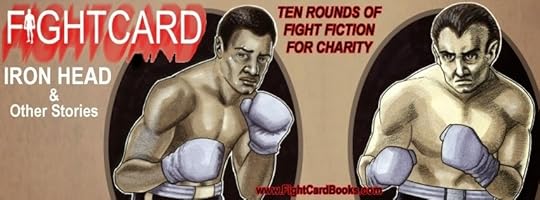
January 21, 2014
FIGHT CARD, CHARITY, AND COMMUNITY
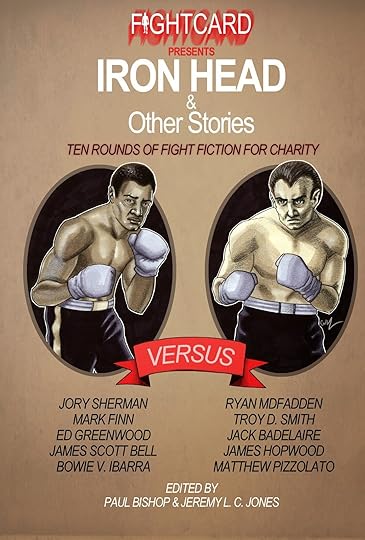
FIGHT CARD, CHARITY, AND COMMUNITY
What is community? Is it simply a geographic area where people group together while leading separate lives? Is it a social network composed of friends who like or comment while committing nothing of themselves beyond a mouse click? Or is true community something stronger, something deeper, something going beyond the individual into compassion and caring for others in thought, effort, sacrifice, and service?
When Mel Odom and I created the Fight Card mandate in 2010 (a series of monthly 25,000 word boxing novelettes … short, sharp, hard-punching stories inspired by the fight pulps of the ’30s and ’40s), we had no idea we were creating a community. However, Fight Card quickly took on a life of its own.
“Build it and they will come,” was the call to action in the iconic baseball novel Field Of Dreams by W.P. Kinsella, but the same creative magic took over Fight Card … We built a virtual boxing ring to which fighters, writers, and readers have come.
As of this writing, the Fight Card series has extended to thirty titles, with more in the battered and scarred editorial dressing room waiting for their chance to duke it out in publication. The Fight Card brand has extended to include Fight Card MMA, Fight Card Now, Fight Card Luchadores, Fight Card Sherlock Holmes, and even Fight Card Romance.
Experienced authors and critically acclaimed newcomers have stepped into the Fight Card ring, going the distance again and again – each delivering a unique, fresh take on the familiar boxing tale of struggle and redemption. In the process, all of those involved – writers, editors, publicists, readers, cover artists, etc. – have become a community, a caring community.
Fight Card transformed from a publishing brand into a living, breathing, author cooperative with each writer working off of his own Amazon platform for his/her own Fight Card entry, while being supported by the cooperative – covers, editorial, formatting, publicity, podcasts, etc. – but also supporting the cooperative by furnishing back their own talents in those and other areas.
For me, Fight Card has become a true joy. Every day, I get to interact with writers, illustrators, and pulp aficionados from literally around the world. Figuring out the time change for Skyping between California and Australia, Spain, or Ireland regularly makes my head hurt.
Plus, I’m having a blast bringing these great stories to fruition by taking advantage of the ever-evolving e-book technology to reach an audience in a manner not possible through traditional legacy publishing. Still, while Fight Card has been on the cutting edge of both the New Pulp and the publishing revolution, I felt we could do more. Be more.
Which brings us to this anthology. Part of a true community is giving back to others. Six months ago, Jeremy L.C. Jones asked me if I’d be interested in helping out an author-in-need by letting him do a quick turnaround writing a Fight Card book. I’d already been toying with the idea of doing a Fight Card anthology to benefit a literacy charity, but here Jeremy was opening a different sort of door.
Author-in-need might sound redundant. Aren’t all authors in need – in need of new readers, more book sales, and a solid plot for their next book? But, this was different. This was need based on health problems, family financial problems – needs that would crush the creativity out of anyone, let alone an experience, revered, writer who, like so many of the rest of us, works the typewriter trapeze without a safety net.
Jeremy and I put out feelers to our Fight Card community and the response was instantaneous. Without hesitation, a large number of writers – some already part of the Fight Card team, others independent fighters happy to come into the Fight Card fold – willingly offered to write fight stories for not only our initial author-in-need charity effort, but enough to fill a schedule for three other charity anthologies now scheduled for upcoming publication.
Amazing.
Words on paper are the life blood of a writer. Hemingway said, “There is nothing to writing. All you do is sit down at a typewriter and bleed.” These writers were willing to bleed in order to give a transfusion to one of their own – and then continue to bleed to give a transfusion to literacy charities in support of that most precious of commodities … readers.
In Fight Card Presents: Ironhead And Other Stories, ten writers (Jory Sherman, Ryan McFadden, Mark Finn, Troy D. Smith, Ed Greenwood, Jack Badelaire, James Scott Bell, James Hopwood, Bowie V. Ibarra, and Matthew Pizzolato, along with cover artist Carl Yonder) take us into the squared circle against a plethora of dangerous, hard-hitting, and deadly opponents – all in the name of community.
100% of the proceeds from these Fight Card anthologies go directly to the designated author-in-need or chosen literacy charity. There are no monies taken for administrative costs or any other incidentals.
This is what community is all about. I am humbled to be a part of it and honored to work with not just the writers and artists represented in this volume, but also in the others to come.
In buying this anthology, you too are part of our community, part of something larger … part of going the distance … of not leaving those in need behind …
Keep punching!
Paul Bishop
Los Angeles, January, 2014
FIGHT CARD UPDATE
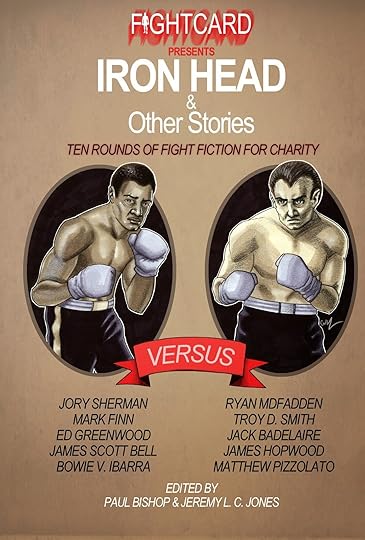
FIGHT CARD UPDATE
The Fight Card team is excited to announce the release of our first ever Fight Card CHARITY anthology. Part of the Fight Card mandate as an author’s cooperative is to give back to our community. This debut project, Fight Card Presents: Iron Head & Other Stories – Ten Rounds of Fight Fiction for Charity, is the first step. Three other charity anthologies will follow during the course of 2014. If you would like to provide a story, please contact either myself or Jeremy L. C. Jones.
One hundred percent of all royalties from these anthologies will go directly to an author-in-need or a literacy charity. Royalties from our debut charity anthology will go directly to ailing western writer JORY SHERMAN, whose family has been financially devastated by medical bills related to Jory’s illness. Jory is a revered writer known primarily for his award winning westerns, but has also written in many other genres. He has also been a mentor and good friend to many other writers.
Fight Card Presents: Iron Head & Other Stories is a 60,000 word anthology of two-fisted action by authors from multiple genres, There’s Jack Badelaire, James Scott Bell, Mark Finn, Ed Greenwood, James Hopwood, Bowie V. Ibarra, Ryan McFadden, Troy Smith, Matthew Pizzolato, and Jory Sherman writing the title story. There’s also a foreword by Paul Bishop, an introduction by Jeremy L.C. Jones, and a cover by Carl Yonder.
It is particularly important to help us spread the word about this anthology via blogs and social networks. Please help us make a difference two dollars and one punch at a time!
FIGHT CARD PRESENTS: IRON HEAD & OTHER STORIES
Fight Card Presents: Iron Head & Other Stories is the first in a series of charity anthologies from the Fight Card authors cooperative – a writers community featuring many of today’s finest fictioneers, including Jory Sherman, Ryan McFadden, Mark Finn, Troy D. Smith, Ed Greenwood, Jack Badelaire, James Scott Bell, James Hopwood, Bowie V. Ibarra, and Matthew Pizzolato.
Compiled by Paul Bishop and Jeremy L. C. Jones, 100% of the proceeds from these anthologies will go directly to an author-in-need (in this case, revered western writer Jory Sherman) or a literacy charity. Words on paper are the life blood of a writer. The writers in this volume were willing to bleed in order to give a transfusion to one of their own – and then continue to bleed to give a transfusion to literacy charities in support of that most precious of commodities … readers. They are true fighters, every one …
Much more coming from Fight Card in 2014 … So, hang on and …
Keep punching!
January 10, 2014
FAST FIVE WITH SAM HAWKEN

FAST FIVE WITH SAM HAWKEN
FIGHT CARD MMA: ROSIE THE RIPPER AUTHOR SAM HAWKEN (WRITING AS JACKS BLOG, YOU WOULD SAY THAT, WOULDN’T YOU?
Fight Card opens round one of 2014 with a scorching Fight Card MMA entry, Rosie The Ripper, from critically acclaimed writer Sam Hawken (writing as Jack Tunney). He is the author of The Dead Women Of Juárez, Tequila Sunset, Juárez Dance, La Frontera, and the Camaro Espinoza novellas. Fight Card MMA: Rosie The Ripper is his first Fight Card entry …
The genesis of Rosie The Ripper was a little different than all the other Fight Card entries since it started with a cover without a story. How did that work for you?
I wrote in an essay everyone can find on the Fight Card site about how I’m a more visual person, and what’s more I happen to be intensely interested in women’s MMA. With the Rosie cover, the two of these things collided and I immediately started thinking “I need to write this thing because it’s right up my alley.” The only problem I had was I couldn’t come up with something to fit the Fight Card format. It took me close to a year of ruminating on the cover, coming back to it periodically, until I finally figured out how to make it work. It was so easy in the end that I’m not sure what took me so long. It helps that the cover (by Keith Birdsong) is great because you want a great story to go along with it and that inspires you to keep trying.
FOR THE FULL INTERVIEW CLICK HERE

FIGHT CARD MMA: ROSIE THE RIPPER
Baltimore, 2014 … Rosie Bratton is a recovering alcoholic. Divorced, working a dead end job, and with a young daughter she only sees on alternate weekends, her life is going nowhere. Her hopes hang on the outcome of a custody battle to regain primary custody of her daughter, and the vague possibility things might get better together.
When circumstances turn bleak, Rosie nearly retreats into the bottle, but her sponsor has a solution. Felix was once a mixed martial arts contender. Now, he has turned his talent toward teaching his skills to others. If Rosie becomes his student, he hopes she can learn how to be a stronger, focused, better person.
Some people are born to fight – in the cage and out – and Rosie is one of them. When she’s given the moniker Rosie the Ripper, she becomes something more than she was before – and it may be enough to give her a fighting chance …
January 6, 2014
WRITING FIGHT CARD MMA: ROSIE THE RIPPER
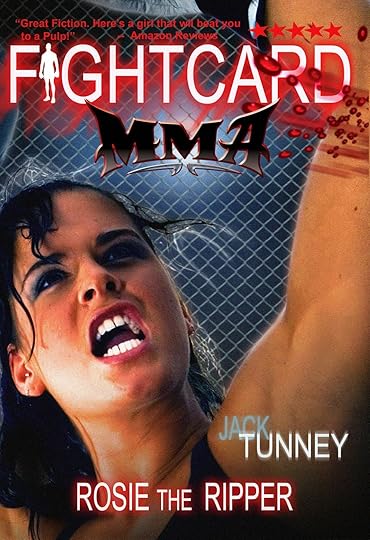
WRITING FIGHT CARD MMA: ROSIE THE RIPPER
SAM HAWKEN
I’m a pretty visual person. When I was younger, I wanted to direct movies and only gave up that dream when I discovered making movies required large amounts of money, which I never had. Far, far cheaper to make paper movies out of words. And so it goes.
When Paul Bishop first announced the Fight Card MMA line, he posted a picture of a mock-up cover done by Fight Card artist Keith Birdsong. The cover was a dynamic image of a woman in mid-punch and the title was Rosie the Ripper. Seeing this got me thinking. It was that visual part of my brain going to work.
I’d been aware of the Fight Card series and read a few, but it wasn’t until I saw Rosie and those magic letters, MMA, pop up that I felt I could actually write one of these things. A long-dormant novel idea about a boxer in Baltimore never really seemed to get anywhere, but Rosie the Ripper kept asking for my attention as the weeks and months went by until finally her storyline came springing into my head, ready to be written.
Mixed martial arts hits some strange, buried sweet spot even boxing – a sport I’ve followed for decades – has never managed to touch. There’s something about the mixed part of mixed martial arts that really gets me interested, as there are so many technical elements that go into the execution of a successful fight. Boxing is intricate and far more complex than non-fans give it credit for, but MMA is a whole other level. Striking, clinching, grappling, submissions – it goes on and on. And for me, anyway, some of the most interesting MMA is happening with women fighters.
There have been female boxers for time out of mind, but MMA has integrated women into the sport in a much more organic way. Rosie the Ripper was my chance to translate some of that feminine energy into an action-packed fight story. But I’d go one better and place a layer of drama over the raw physicality. Drama geared specifically toward family, personal tribulations, and redemption.
The very best fight movie ever made is Rocky, and though Rocky Balboa was a gofer for a small-time loan shark, his story was never about crime. It was about heart. There was his relationship with Adrian and Mickey, and his struggle to actualize himself as a person. I didn’t think I could reach those Oscar-winning heights, but I could at least try to create a human portrait of a woman and her life in MMA.
Rosie Bratton is a fighter – a given in a Fight Card tale – but she comes to her fight the long way round. Divorced, with a young daughter she only sees on alternate weekends, Rosie’s first real battle is with the bottle. When her custody struggles with her successful ex-husband turn sour, she feels a renewed pull toward drink.
Her AA sponsor, Felix Treviño, recognizes the signs and know she needs something on which to focus her disparate energies. Once upon a time, in another life, Felix was an MMA contender, and he has turned his skill toward training others like his niece, Tina. For Felix, MMA is not only a path toward physical strength, but also toward mental toughness and stability. He believes MMA training is what Rosie desperately needs.
I believe in fight training’s ability to form positive connections in a person’s life. I’m in my forties now and pretty much settled, but there was a time when I was not so old and not so settled, and for a time I took solace in learning to box. I was never any good, and I never progressed to the point where I was even safe to be in the ring sparring with another human being, but I did learn and I did feel better. In the intervening years, I’ve wished I’d stuck with it, because as a body slides into middle age the spirit is willing, as they say, but the flesh is weak.
From time to time, I’ll see an advertisement on the side of the road for some Brazilian jiu-jitsu place. There is also a gym right down the road from me, which sponsors actual, honest-to-goodness professional MMA fighters. I sometimes consider these things and I wonder if maybe there’s enough gas left in the tank to roll with the young guys and learn a thing or two. Then I remember I get winded eating a particularly large salad and the thought is whisked away.
One thing a guy like me can do, however, is read and write about the sport. I’m heavily into it in a way I wasn’t just a few years ago – and I pay particular attention to WMMA. I spend a surprising amount of my time keeping up with developments in the mixed martial arts world, so I suppose it was inevitable I would write something like Rosie the Ripper, even if Paul Bishop hadn’t done me such a big favor by posting that cover so long ago.
I see fight fiction as a natural extension of fandom. There was time in the ‘30s and ‘40s when boxing was very much a mainstream sport. However, when men (and it was mostly men) weren’t watching boxing matches or reading The Ring, they were snapping up pulps written by authors like Robert E. Howard. Sports fiction of all sorts was big back then’ Along with boxing there were pulp magazines for baseball and football – and even basketball. No one thought it was odd to read such things.
Now, though, things are different. The pulps of yesteryear have all gone away. Football fans don’t read Football Action anymore and Baseball Stories doesn’t exist. There are still those who seek out these old entertainments on eBay or at estate sales, but by and large, the pastime of reading fiction about favorite sports has died.
There is no good reason for this to be the case. I expect Paul Bishop and Mel Odom, who inaugurated the Fight Card brand, feel much the same way. Why not bring back the old days, but with a new twist? Like fashion, everything old can be new again …
If I’m any example of this, you can use me to prove the point: people will read sports fiction if it’s made available. And, as combat sports like MMA grow in visibility and popularity, now is the perfect time to introduce enthusiasts to the pleasure of fight stories. There’s no one to tell anyone it’s wrong, bad or weird to extend their enjoyment of MMA or boxing into their reading lives. In this respect, Fight Card is doing both fighting sports and fiction a huge service.
I now get to be a part of it all – and Rosie does, too. Alongside the various bruisers and brawlers of the Fight Card family, this determined single mother has punched her way into her own story. And I get to do something I love: write about fun stuff. Sure, I know MMA can be vicious and bloody, but it’s also full of great yarns about heart, perseverance and triumph. And that’s just the real fighters! The situation goes into overdrive once the fictioneers get involved in the process.
That cover of Rosie the Ripper gave me the first inkling of an idea that maybe I could do this. Maybe I could write the sort of thing fight fans would enjoy. I’d made my bones with bleak, despairing crime fiction, but here was something altogether different.
I could stretch myself in ways I hadn’t done before, could balance on a high wire strung between action and drama with no net underneath. I could write about hope and the unbreakable spirit of a fighter. Aren’t these the kinds of things that draws all of us to the cage or the ring? We want to see the punches and the kicks and the vicious submission holds, but we also want to know two people are giving their all to fight three rounds and come away victorious. Two real, flesh-and-blood people who have all their dreams tied up in the moment when the referee raises their hand.
So maybe I pulled it off. Maybe I didn’t. The point is, I gave it my best shot. I worked hard, I visualized the victory and, when the time came, I threw those punches just as hard and as fast as I could. I may not ever do so much as exchange pitter-pat strikes with another MMA student on the mats in some gym, but I feel like I stood beside a woman who did that and more. Rosie’s triumphs are my triumphs, her failures my own. I imagine pretty much any writer in the Fight Card stable would say the exact same thing about their protagonists. That’s the thing about fight fans: we put ourselves at the end of those punches.
And as it happens, I think Rosie the Ripper might also make a pretty good movie. I’m available to direct.
FIGHT CARD MMA: ROSIE THE RIPPER
Baltimore, 2014 … Rosie Bratton is a recovering alcoholic. Divorced, working a dead end job, and with a young daughter she only sees on alternate weekends, her life is going nowhere. Her hopes hang on the outcome of a custody battle to regain primary custody of her daughter, and the vague possibility things might get better together.
When circumstances turn bleak, Rosie nearly retreats into the bottle, but her sponsor has a solution. Felix was once a mixed martial arts contender. Now, he’s turned his talent toward teaching his skills to others. If Rosie becomes his student, he hopes she can learn how to be a stronger, focused, better person.
Some people are born to fight – in the cage and out – and Rosie is one of them. When she’s given the moniker Rosie the Ripper, she becomes something more than she was before – and it may be enough to give her a fighting chance …

